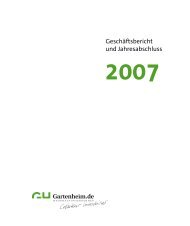analysis of the influences of solar radiation and façade glazing ...
analysis of the influences of solar radiation and façade glazing ...
analysis of the influences of solar radiation and façade glazing ...
You also want an ePaper? Increase the reach of your titles
YUMPU automatically turns print PDFs into web optimized ePapers that Google loves.
1.2 Background <strong>and</strong> literature review 33<br />
in <strong>the</strong> simulation <strong>of</strong> completely unknown systems because <strong>the</strong> authors obtained predictions<br />
within 7.1 % <strong>and</strong> 9.7 %.<br />
The results <strong>of</strong> computer simulations <strong>of</strong> <strong>solar</strong> domestic hot water systems, based on <strong>the</strong> time<br />
marching model, were obtained by Bojic (Bojic, et al., 2002). The analyzed system, which<br />
was used for a typical Yugoslavian family, consisted <strong>of</strong> a flat-plate <strong>solar</strong> panel having an<br />
area <strong>of</strong> 3 m 2 , a storage tank (volume ranged from 60 l to 400 l), an auxiliary heater <strong>and</strong> a<br />
mixing device. A computer tool called TEMP was created which can be used to design <strong>and</strong><br />
operate SDHW systems. Estimates showed, among o<strong>the</strong>r things, that when <strong>the</strong> volume <strong>of</strong> a<br />
storage tank is larger, <strong>the</strong> fraction <strong>of</strong> <strong>solar</strong> <strong>radiation</strong> is less sensitive to a variation in <strong>the</strong><br />
operation parameters <strong>of</strong> <strong>the</strong> system.<br />
Furbo <strong>and</strong> co-workers (Furbo a, et al., 2005) investigated small systems in which domestic<br />
water may be heated by <strong>solar</strong> collectors or by an auxiliary electric heat source. Three<br />
different tanks (one traditional <strong>and</strong> two smart), shown in Fig. 1.11, were experimentally<br />
<strong>and</strong> <strong>the</strong>oretically examined in <strong>the</strong> same operating conditions.<br />
electric<br />
heating<br />
element<br />
to <strong>solar</strong><br />
collector<br />
cold water hot water<br />
electric<br />
heating<br />
element<br />
from<br />
<strong>solar</strong><br />
collector<br />
electric<br />
heating<br />
element<br />
to <strong>solar</strong><br />
collector<br />
plastic<br />
pipe<br />
to <strong>solar</strong><br />
collector<br />
cold water hot water<br />
Fig. 1.11: Three <strong>solar</strong> tanks investigated by Furbo at. al (2005).<br />
side arm<br />
from<br />
<strong>solar</strong><br />
collector<br />
cold water hot water<br />
electric<br />
heating<br />
element<br />
from<br />
<strong>solar</strong><br />
collector





